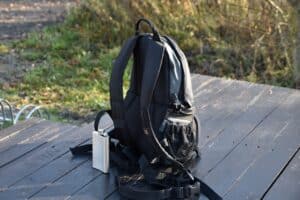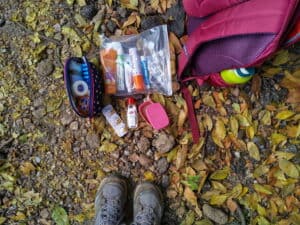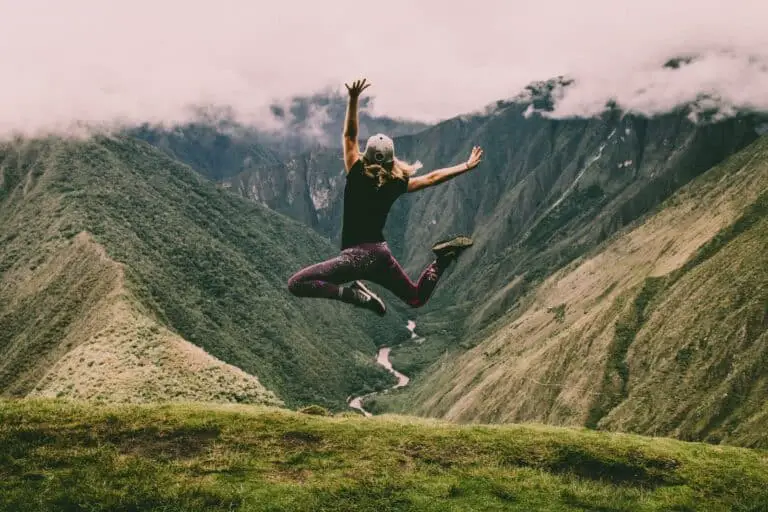Fear not, ladies! Hiking alone doesn’t have to be intimidating. With the right knowledge and preparation, it can be a liberating and empowering experience. I’m here to share my top tips for hiking alone as a woman.
We’ll delve into everything from picking the right gear to ensuring your safety. We’ll also discuss how to mentally prepare for your journey. So, lace up those boots, grab your water bottle, and let’s get started.
Whether you’re a seasoned hiker or a newbie, these tips will help you confidently conquer the great outdoors. So, stay tuned and get ready to embrace the adventure that awaits you.
Choosing the Right Trail

Just as important as your gear selection is picking the right trail. Scouting out your path before setting out is key for a successful solo hike.
When choosing a trail, I prefer ones that are well-traveled. This can be a comfort, especially for first-time solo hikers. It’s common to worry about isolation on the trail. However, choosing high-traffic paths ensures you’re never too far from another passerby.
Look for trails with good signage. They’re typically easier to follow, and you’re less likely to lose your bearings. Remember, it takes but one wrong turn to get lost. So any system that helps maintain direction is a win in my book.
Trail difficulty is another key factor. Understand the terrain and difficulty level before packing your bags. It’s essential to consider your physical fitness and experience. Don’t push yourself on dangerous terrains if you’re not comfortable or trained for it.
Hiking apps are great tools that can help you with this decision. They provide trail maps, reviews, and difficulty ratings. Some popular ones include:
- AllTrails
- Gaia GPS
- ViewRanger
With the right trail, you’ll feel more relaxed and enjoy the calm and beauty nature has to offer.
Essential Gear for Solo Hiking

While choosing the right trail is a critical first step, filling your backpack with the right gear is equally important. Let’s run through some essential items that will keep you safe, comfortable, and ready for whatever the trail presents.
First and foremost comes the hydration critical for any hike. Be sure to pack a reliable, ready-to-fill hydration bladder or water bottle. Hydration-compatible hiking backpacks also offer easy access to water and keep your hands free for better balance and positioning.
Another must-have is a hiking map from reliable mapping apps like AllTrails, Gaia GPS, or ViewRanger and a durable, water-resistant hardcopy for backup. Navigating the trails using these map sources can make all the difference while avoiding potential mishaps.
Let’s not overlook food. Keep a good stock of nutritional hiking snacks like trail mix, energy bars, dried fruits, or jerky. A well-nourished hiker is a contented hiker. And yes, never underestimate the power of a spontaneous energy boost when you’ve hit a challenging stint!
Now let’s talk clothing. Dressing in layers is key – starting with moisture-wicking base layers to keep you dry, insulating middle layers for warmth, and a waterproof top layer to shield you from unexpected weather conditions. Quick-drying, durable and comfortable hiking shoes or boots are also a must.
Your first-aid kit should be stocked with essentials like bandages, antiseptic wipes, and common medication for headaches or allergies. Safety should always come first and a well-stocked first-aid kit is a solo hiker’s best friend.
On the technical side, a multi-tool, navigation tools like a compass and GPS, and fire-starting materials can save the day when you’re alone on the trail. And of course, let’s not forget the all-important flashlight or headlamp!
And last but not least, consider investing in some personal safety gear. This could include pepper spray, a personal alarm, or even a satellite phone if you’re planning an extended solo hike in remote areas. As a female hiker, these items offer an added assurance and can make your solo hike not only safer but also more comfortable and enjoyable.
And there you have it, a basic list of essential gear for solo hiking. These are vital tools that every female hiker should consider when hitting the trails alone. But
Safety Precautions for Hiking Alone
Safety should be your top priority when embarking on a solo hike. It’s critical to plan and prepare for a self-reliant adventure. In addition to the essential gear we’ve already discussed, let’s dive into some crucial safety measures that can make your hiking experience safer and more enjoyable.
Inform Others of Your Plans: Before you venture off into the great outdoors, tell someone about your hiking plan. Provide them with specifics including your trailhead, planned route, and anticipated return time. If something were to happen, this information will be invaluable in locating you.
Learn Basic Survival Skills: Brushing up on basic survival skills is always a good idea. This might include learning to navigate without a compass, starting a fire, or building a shelter. Better yet, you can pack a survival guidebook in your backpack for a quick reference on the trail.
Hike during Daylight: Avoid hiking in the darkness. Not only does this help prevent accidents, it also reduces your chances of encountering wildlife. As a general rule, plan your hikes so you’re back at your starting point well before dusk.
Stick to Marked Trails: Veering off the marked trail increases your odds of getting lost and potential danger. Therefore staying on the clearly marked paths can help ensure your safety.
Planning for Emergencies

In the course of your solo hiking journey, it’s important to be prepared for potential emergencies. Even if you’re following all the safety guidelines, unexpected situations can still pop up. To encounter such situations, you need to be equipped with the right knowledge and tools.
First on the list of essentials is a well-stocked first aid kit. This should include items like adhesive bandages, antibiotic ointment, antiseptic wipes, aspirin, etc. You’d be surprised how handy a first aid kit can be when you’re faced with minor injuries like cuts, scrapes, or sprains.
Another critical piece is a multi-tool. An ideal multi-tool should have a knife, screwdriver, can opener, and other useful features. This compact tool can assist you in many ways. For example, you can use the knife to cut branches or fruits you find along the way.
Also, it’s highly recommended to have a whistle. Sounds strange? Not at all. In case you’re lost or stranded, a whistle can act as an alarm to attract attention. Three short bursts of sound is the universal signal for distress.
Beyond physical tools, it’s equally important to know basic emergency procedures. Understanding how to treat a wound, provide CPR, or even how to react when faced with a wild creature can be crucial to your survival. There are many classes and online courses available to help you achieve this.
Don’t forget about having emergency contact numbers handy. Having them saved on your phone isn’t enough. Since losing power or signal is common in remote areas, it’s best to have them written somewhere accessible.
Lastly, you must remember that planning for emergencies isn’t a sign of pessimism. It’s a matter of being responsible and ensuring that you enjoy your solitary hike without any worry.
Remember, solo hiking is an amazing experience, but it’s only truly enjoyable when you’re well-prepared and safe. In the following sections, you’ll get more exclusive tips to maximize your solo hiking experience.
Building Confidence and Mental Preparedness
Now that we’ve addressed the tangibles like a well-stocked first aid kit and a pocketful of emergency contact numbers, let’s delve into the intangibles. Your mental fortitude is as important as your physical preparedness when hiking alone, especially as a woman.
Believe you can achieve your adventure objectives, but this confidence doesn’t emerge overnight. It’s a culmination of continuous practice and small victories. Begin with shorter, familiar trails and gradually venture towards more challenging terrains. Like any other skill, building confidence is a process. Celebrate the small wins along the way. Remember, the goal isn’t just the summit, it’s the journey getting there.
There’s also no shame in discomfort, fear, or retreating when things don’t go as planned. Listening to those jitters can actually be a significant strength. They sharpen your senses, enhancing your ability to recognize potential risks and take quick, considered decisions. Confidence doesn’t mean disregarding intuition or signals that something isn’t right. When you’re hiking alone, knowing when to step back is just as crucial as the courage to take that leap forward.
Mental preparedness is beyond just confidence. It’s about visualizing scenarios, honing your problem-solving skills, and being resilient in the face of adversity. One method to aid this is mental contrasting. This technique involves picturing the best outcome of your hike, then mentally visiting the challenges that could arise and how you’d handle them. Prepping your mind can reduce anxiety and nurture a real sense of empowerment.
To reinforce your mental resilience:
- Engage in regular physical fitness activities
- Nurture a positive attitude
- Practice mindfulness and meditation
- Encourage self-talk
Remember that solo hiking is as much a mental game as it is physical. More data, tips and strategies for safe and satisfying solo hikes are on the way, keeping in mind these foundations of mental preparedness and confident decision-making.
Conclusion: Tips for Hiking Alone as a Woman
The journey of hiking alone as a woman isn’t just about the physical challenge. It’s about conquering your fears, embracing your strengths, and growing mentally. Remember, it’s okay to start small. Celebrate each milestone, no matter how minor it may seem. Listen to your instincts – they’re your best guide when you’re out there alone.
Visualize potential scenarios and sharpen your problem-solving skills. Resilience is key. When faced with adversity, remember that it’s an opportunity for growth. Hiking alone is a mental game just as much as it’s a physical one.
Stay tuned for more tips and strategies that’ll help you embark on a safe and satisfying solo hiking journey. You’ve got this!

